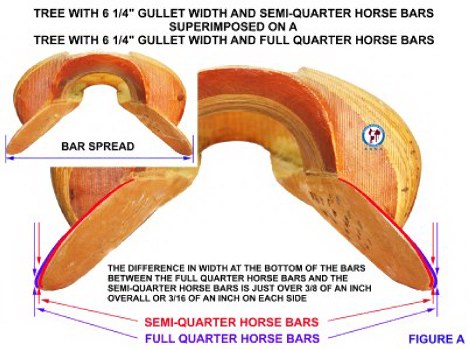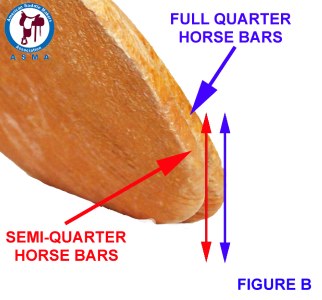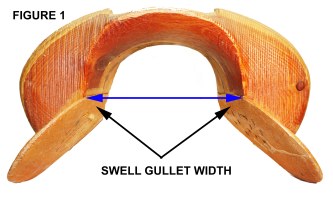BAR ANGLE VS GULLET WIDTH
|
Having determined that the bar angle is the defining element of the tree as to saddle fit, there are other terminologies being used in relation to bar angle, that are open to interpretation and have a tendency to be misleading and prone to misconception.
The biggest culprit is gullet width.
|
|
Some have interpreted a flatter angle to be wider and thus a wider gullet. A flatter angle will produce a wider measurement at the bottom of the bars ( see FIGUREs A and B ) but not at the top of the bars where gullet width is measured. This measurement at the bottom of the bars ( see inset in FIGURE A ) is referred to as spread, bar spread, or gullet spread. As stated before, Although related, bar angle and gullet width are independent measurements. One can have bars set at an angle for an upright or steep profile with a gullet width of 6 ½" or bars set at an angle for flat or spread out profile with a gullet width of 6 1/4" .
  The difference in width at the bottom of the bars between the “historical” full-quarter horse bars and the “historical” semi-quarter horse bars is just over 3/8 of an inch overall or 3/16 of an inch on each side.
NOTE: This example is from one tree maker’s “semi-quarter” horse bars and “full quarter” horse bars; another tree maker may differ.
|
|
This problem stems from definitions where some saddle tree makers and saddle makers/companies have incorporated gullet width and bar angle into a generic term. These generic terms have worked well on the past for the large tree and saddle companies building and selling saddles for a wide variety of horses and riders. For example:
NOTE: ASMA does not agree with this terminology as stated, the information is somewhat outdated and contradicted by other sources and this example is only used for the purposes of illustration.
This information or variations there of has been and is widely used by many in books, articles, saddle catalogs and especially on the Internet. Therefore, this leads to the misconception that the tree bars description will have a specific gullet width. So when a rider is told they need a wider saddle they use this information and seek a saddle with full quarter horse bars. Which they may or may not need. So, when it is stated a wider tree is needed, the statement should be compound reflecting the two separate measurements.
|
e-mail mailto:info@saddlemakers.org
Copyright 2005 - 2016 American Saddle Makers Association, Inc.

